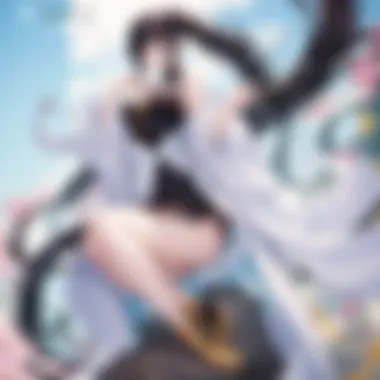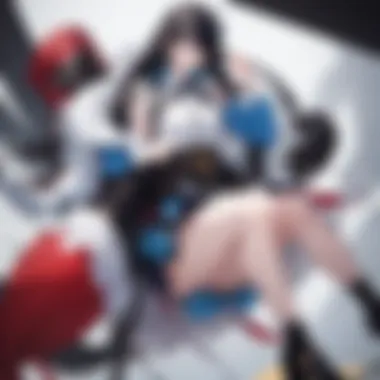Exploring Lookism in Manhwa: Cultural Implications


Intro
Lookism, the bias people face based on their appearance, has been a prevalent theme in many narratives, particularly within manhwa. This exploration reveals how cultural perceptions of beauty affect character dynamics and societal norms. The insights presented in this article delve into the significant implications of lookism within manhwa narratives. With a considerable influence on both character development and reader perceptions, this phenomenon calls for an in-depth examination of its cultural roots and relevancy today.
As we embark on this investigation, we will analyze specific series that personify these themes. Examining character arcs and the environment in which they exist allows us to uncover the deeper meanings embedded in manhwa. Through the lens of lookism, we can uncover how these narratives challenge or reinforce existing beauty standards in society.
Featured Series or Manga
Manhwa such as "True Beauty" and "Lookism" have portrayed lookism in striking ways. These series not only engage readers but also spark discussions about societal judgment based on appearance.
Overview of the Series
True Beauty explores the life of Jugyeong Lim, a girl who faces bullying due to her looks. She discovers the transformative power of makeup, which drastically alters how she is perceived. This manipulation of appearance leads to a deeper exploration of self-worth and identity.
In contrast, Lookism features Daniel Park, who possesses the ability to switch between two bodies—one attractive and one less so. This gimmick allows for a unique perspective on societal treatment based on physical appearance, highlighting the stark differences in how people react to beauty.
Key Characters and Development
In True Beauty, Jugyeong is forced to navigate her new life while wrestling with her internal conflicts about beauty and acceptance. The various characters surrounding her contribute to her journey, each offering insights into how lookism shapes interactions.
Similarly, Lookism features a range of characters, from bullies to admirers, who represent various societal attitudes towards appearance. Daniel's character development throughout the series underscores the duality of perception and reality.
Character Analysis
Major Characters
The primary characters in these two manhwa serve as conduits through which the themes of lookism are explored. For Jugyeong, her struggles reflect the societal pressures women face regarding beauty. Daniel, on the other hand, represents a more exaggerated exploration of your worth as judged by others.
Character Arcs and Growth
Throughout True Beauty, Jugyeong evolves from being insecure about her looks to gaining confidence, though her journey is complicated by societal expectations of beauty. Daniel's narrative takes a different route. He learns that looks can influence but do not define a person’s worth. Both journeys tie together to showcase real-world struggles related to appearance.
Thematic Exploration
Main Themes and Messages
These series present clear messages about how beauty standards impact interpersonal relationships. The notion of worth being tied to looks is critically examined. Both manhwa challenge the notion that external appearances are irrefutable measures of a person’s abilities or character.
Cultural Context and Influences
The portrayal of lookism in manhwa reflects a larger societal critique of beauty standards in South Korea and beyond. These narratives urge readers to reflect on their own perceptions and societal norms, promoting a conversation about inclusivity and acceptance. They also serve as a mirror, provoking thought on how media reflects and impacts societal values.
The portrayal of lookism in manhwa serves as a catalyst for discussion about beauty standards, identity, and self-worth in a visually driven society.
By understanding these narratives, readers can better grasp the underlying cultural commentary on looks and their implications. This exploration establishes a foundation for further examination into the intersection of manhwa and societal values.
Understanding Lookism
The concept of lookism plays a crucial role in the narratives and themes present in manhwa. Understanding lookism helps readers to dissect its implications within stories and society. In manhwa, characters often face challenges that stem from their physical appearance, making this concept central to character development and plot progression. The exploration of lookism not only enhances engagement but also provides commentary on real-world beauty standards and social dynamics. When readers grasp the nuances of lookism, they can better appreciate how these stories reflect broader societal attitudes toward attractiveness and the subsequent consequences on relationships and identity.
Defining Lookism
Lookism, at its core, refers to the discrimination or prejudice based on physical appearance. This term often intersects with issues of beauty standards, where societal norms dictate what is considered attractive. In manhwa, characters frequently experience advantages or disadvantages based solely on their looks. This focus allows for a deeper engagement with themes of self-worth, acceptance, and the often superficial nature of social networking. As such, lookism can serve as a device to critique the obsession with appearance while also offering characters pathways toward self-discovery in a world that prioritizes looks.


Historical Context of Lookism
Historically, the perception of beauty and its association with power and status has evolved across cultures and eras. In many societies, certain attributes, such as fair skin or specific body types, have been idealized, leading to the establishment of varying beauty norms. Within manhwa, these historical contexts emerge to shape characters and plotlines. Some stories may draw from historical precedents to illustrate how these standards have been internalized. This critical understanding can provide readers with insights into how cultural practices influence perceptions of beauty. Additionally, examining past beauty ideals can help illustrate shifts toward more inclusive definitions of attractiveness.
Lookism in Modern Society
In today's world, lookism remains a prominent issue, as media continues to amplify standards of beauty that often exclude a large portion of the population. The rise of social media has further complicated these dynamics, promoting curated and filtered images that reinforce certain ideals. Within manhwa, the portrayal of lookism reflects these contemporary challenges. Characters who do not fit the mold may struggle in social settings or romantic relationships, providing fertile ground for conflict and growth.
Understanding this modern resonance of lookism amplifies its significance in storytelling. It emphasizes how personal experiences can be affected by external standards. Moreover, the narratives that revolve around lookism may serve to empower readers, offering perspectives that underline the necessity for self-acceptance and the kindness in staying true to oneself despite societal pressures.
"The recognition of beauty standards is essential for comprehending their effects on our interactions and societal structure." - Wikipedia
The Role of Manhwa in Depicting Lookism
Manhwa is not just a medium for entertainment; it serves as a mirror reflecting societal values and norms. The portrayal of lookism within this format offers a profound commentary on beauty standards and their implications. This section aims to explore the multi-faceted role that manhwa plays in portraying lookism, including the visual aesthetics at play and the narrative structures that shape these stories.
Visual Aesthetics and Character Design
Art Styles Influencing Perception
Art styles in manhwa significantly influence how characters and their attributes are perceived. The distinct line art and color palettes used can either enhance or undermine traditional beauty standards. For example, the use of vibrant colors often creates an idealized image of beauty, highlighting features that society has labeled as attractive. This approach helps to define characters through visual appeal, and it plays an important role in the stories.
One key characteristic of this aspect is the exaggerated physical features often seen in manhwa characters, such as large eyes and slim figures. This choice is beneficial for capturing attention. However, it also raises questions about unrealistic beauty expectations imposed on readers. The unique feature here is the creation of visually striking characters, which can both engage the audience and perpetuate specific stereotypes.
Character Archetypes and Beauty
Character archetypes in manhwa often reflect common beauty ideals, thereby influencing readers' perceptions of identity. The trope of the “pretty boy” or “gorgeous girl” creates clear expectations surrounding personalities and roles within the narrative. This choice appeals to audience emotional connections, making characters more relatable or aspirational.
A notable disadvantage arises when these archetypes reinforce superficial judgments about worthiness based on looks alone. This representation can hinder the development of characters who may possess depth or other appealing traits. Overall, though engaging, reliance on beauty archetypes can limit the complexity of character development.
Narrative Structures
Plot Development Shaped by Appearance
In many manhwa stories, character appearances significantly shape plot development. The narrative often hinges on how characters are treated based on their looks. This factor enhances the emotional stakes involved in conflicts and relationships, making it a critical element of storytelling.
A central characteristic of this narrative approach is the juxtaposition between appearance and inner qualities. This duality grants depth to plots, as individuals are often forced to confront their biases—whether they are the protagonists or antagonists. The primary advantage of this approach is its ability to critique societal norms indirectly.
On the downside, excessive focus on appearance can overshadow other themes that may also deserve exploration. Reader engagement may fluctuate when narratives become too predictable in their reliance on looks as a primary motivator.
Conflicts Arising from Beauty Standards
Many manhwa depict conflicts that emerge directly from societal beauty standards. These storylines often focus on the psychological and social implications for characters facing judgment or discrimination due to their looks. The key characteristic here revolves around internal and external strife. Characters may find themselves grappling with self-worth while facing societal pressures that dictate their value.
This approach is beneficial as it offers a layered examination of how lookism permeates different aspects of life. The conflicts can become vehicles for illuminating broader trends in society, showing how the quest for ideal beauty impacts relationships. However, the complexity can have disadvantages as well; narratives may become convoluted if too many angles are explored at once.
"Society's fixation on physical beauty often intersects with personal value, creating an ongoing cycle of judgment and aspiration."
Overall, the role of manhwa in depicting lookism reveals not just the aesthetic pleasures of visual storytelling but also the weighty socio-cultural discussions that unfold within these narratives. By examining character dynamics and narrative structures, readers can gain insights into the cultural implications embedded in these seemingly simple art forms.
Key Themes in Lookism Manhwa
The theme of lookism in manhwa is pertinent in analyzing the characters and narratives presented throughout. It reveals how beauty and physical appearance shape not just the individual characters but also the overall societal interactions within the storyline. By highlighting key themes such as identity, social hierarchies, and romantic relationships, manhwa provides a platform to engage with complex societal issues concerning appearance. The analysis of these themes helps readers understand the multifaceted dynamics at play.
Identity and Self-Perception


The concept of identity is crucial when discussing lookism in manhwa. Many characters often struggle with self-image, influenced by societal standards of beauty. These characters face internal conflicts as they navigate their perceptions of themselves against the backdrop of society's demands. For instance, a character may start as overlooked due to their appearance but embarks on a journey to find their true identity, often leading to significant character development.
Discussions surrounding identity in lookism-themed manhwa frequently reflect real-life issues many face today. The narrative effectively explores how societal beauty standards can warp personal perceptions.
Social Hierarchies and Favorites
Social hierarchies are prominent in lookism narratives. Often, characters are placed within a hierarchy based solely on their looks. The favoritism shown towards attractive characters can create deep divides among individuals, affecting friendships and rivalries. This theme demonstrates the disparities in treatment within various social circles based on appearance. Characters deemed attractive often receive preferential treatment, while those who do not conform to these standards may be marginalized or bullied.
Such themes resonate as they mimic real societal structures. The portrayal of these hierarchies enables readers to reflect on their own experiences.
Romantic Relationships and Lookism
Romantic relationships in lookism-manwa are frequently complex due to the pressures of attractiveness. Characters often face dilemmas where love interests might prioritize looks over deeper connection, leading to conflicts that drive the narrative forward. This portrayal reveals how relationships are sometimes superficial, driven by desire rather than genuine affection.
The exploration of love and attraction in the face of societal beauty norms prompts discussion about the validity of these relationships. Readers can engage with characters’ choices, prompting deeper thoughts on their values and beliefs regarding beauty in real life.
"In manhwa, lookism is not just about character aesthetics; it is a reflection of cultural values and personal journeys".
Major Works in Lookism Manhwa
Lookism in manhwa presents a significant aspect of cultural commentary. By examining key works within the genre, we can gain a deeper understanding of how beauty standards shape narratives and character dynamics. These stories often challenge societal norms, making them crucial for this discussion. Popular titles highlight broad themes and social reflections surrounding lookism, offering insight into how characters navigate a world fixated on appearances.
Spotlight on Popular Titles
Overview of Plot and Characters
A central characteristic of many manhwa titles addressing lookism is their complex plots featuring characters who grapple with beauty norms. Works such as "Lookism" by Taeyong Park revolve around protagonists who experience drastic changes in appearances. This transformation not only impacts how others perceive them but also influences their self-identity and interpersonal relationships. As a result, these narratives resonate strongly with readers facing similar challenges in a society that rewards physical attractiveness. This aspect becomes a substantial contribution to the dialogue on lookism in manhwa, illustrating the pressures characters endure based on their looks.
Cultural Reception and Impact
Cultural reception of lookism manhwa often reflects broader societal attitudes towards beauty. Many titles gain significant popularity due to their relatable portrayal of social hierarchies. For instance, "My ID is Gangnam Beauty" gained recognition for addressing the psychological effects of societal beauty standards. The unique feature of engaging storylines with engaging characters helps these works capture a wide audience, increasing their impact on discussions about lookism. However, they also face criticism for reinforcing certain stereotypes while attempting to dismantle others, highlighting the nuanced reception of these narratives.
In-Depth Analysis of Character Dynamics
Main Characters and Their Arcs
Exploring the character arcs within lookism-themed manhwa reveals much about the inherent messages in these stories. The main characters often start from a place of insecurity, shaped by public perception and societal expectations. For example, in "Lookism," the protagonist learns about empathy and personal growth through the experiences tied to his dual appearances. This journey not only deepens the narrative but also serves to critique superficial values found in society. Overall, the character arcs provide a thorough exploration of identity and personal development within the context of lookism.
Supporting Roles and Their Functions
The supporting characters in lookism manhwa are equally important in shaping the narrative. They often reflect varying responses to beauty standards, offering a broader perspective on the subject. These roles can serve as foils to the main character, showcasing contrasting views on lookism. For example, a character grappling with their insecurities can highlight the main character's growth. Additionally, supporting characters can provide important subplots that enrich the main narrative, further exploring themes such as friendship and acceptance. This multifaceted approach to character dynamics contributes to a deeper understanding of the social implications embedded in these works.
Cultural Critique and Reality Reflection
In the discussion of lookism, it is vital to explore cultural critique and reality reflection. This aspect allows us to understand how lookism principles are not just theoretical constructs but part of the fabric of contemporary society. It invites a critical examination of not only manhwa narratives but also how these narratives reflect and shape perceptions of beauty in the real world.
Implications of Lookism in Real Life
Effects on Mental Health and Self-Esteem
The impact of lookism on mental health and self-esteem is significant. Many individuals experience negative feelings due to societal beauty standards. This pressure can lead to anxiety, depression, and other mental health issues. Manhwa often mirrors these struggles, presenting characters who grapple with their appearance. This depiction resonates with readers, offering a connection between personal experience and narrative.
Additionally, self-esteem issues emerge as a result of constant comparisons with idealized characters. Readers may internalize these portrayals, believing that appearance dictates worth. This creates an awareness that is crucial for understanding the broader implications of beauty ideals in society. Narratives that highlight these effects provide a compelling commentary on the hollow nature of appearance-focused validation.
Reinforcement of Stereotypes


Lookism in manhwa can also reinforce stereotypes, further influencing societal perception. Characters often embody exaggerated physical traits that align with traditional beauty standards. This portrayal perpetuates narrow definitions of attractiveness, which affect how individuals view themselves and others.
The stereotypes presented, such as the idea that villains often have unattractive features, shape readers' preconceived notions. While this strategy can make narratives engaging, it risks oversimplifying characters and their motivations. Thus, the critical examination of these stereotypes becomes essential. By recognizing them, readers may navigate these narratives more thoughtfully, questioning the biases that they depict.
Counter-Narratives in Lookism Manhwa
Challenging Beauty Norms
Within the realm of manhwa, some works challenge established beauty norms. These stories often present characters who defy traditional standards, offering a richer diversity in character design. This aspect is valuable as it encourages readers to consider alternative notions of beauty.
Rather than adhering strictly to conventional aesthetics, these narratives invite a broader discussion about what constitutes attractiveness. By showcasing characters from diverse backgrounds, they foster appreciation for individual differences. The emphasis on authentic representation contributes positively to the ongoing dialogue surrounding beauty.
Promoting Acceptance and Diversity
Finally, promoting acceptance and diversity is a crucial aspect of current lookism narratives. Many manhwa now depict characters with various body types, skin tones, and features, promoting the idea that everyone has unique beauty. This shift reflects changing societal views on beauty and encourages a more inclusive perspective among readers.
This approach can significantly contribute to self-acceptance and counteract the negative implications of lookism. Readers may feel validated and recognized in their differences, leading to enhanced self-esteem and a sense of community. Therefore, the portrayal of acceptance in diversity represents a progressive movement within the medium of manhwa.
Future Trends in Lookism Manhwa
The exploration of future trends in lookism manhwa is vital for understanding the evolving dynamics between beauty, culture, and identity. As social attitudes shift, so do the representations of beauty and attractiveness in media. This section will examine how manhwa are adapting to these societal changes and identify emerging themes that could shape the landscape of lookism in the genre. The dialogues surrounding lookism are increasingly complex, reflecting broader cultural shifts and encouraging a move away from traditional beauty standards.
Adapting to Changing Societal Views
Manhwa creators are recognizing the importance of adapting to changing societal views on beauty and appearance. This shift highlights the increasing realization that societal norms can no longer be taken for granted. As cultural awareness grows, the narratives within manhwa are beginning to reflect a more diverse range of appearances. Newer titles often showcase protagonists that do not conform to typical beauty standards, emphasizing traits that were once overlooked.
For instance, character designs may focus on unique physical attributes, showcasing flaws as part of individual identity rather than weaknesses. This enables more profound character development and resonates with audiences who may also feel marginalized by conventional beauty ideals. The shift is significant not just for representation but also for changing public perceptions about beauty, allowing readers to engage with characters on a more personal level.
Emerging Themes and Motifs
Emerging themes within lookism manhwa are also worth noting. Recent trends reveal a growing inclination towards narratives where physical appearance is explored alongside deeper, more personal stories. These themes not only fascinate audiences but also stimulate critical thinking about the very construct of beauty.
Some prevalent motifs in recent titles include:
- Redefining Beauty: Characters undergo transformations that teach audiences that beauty is subjective and diverse.
- Inner Strength vs. Outer Appearance: Many stories are focusing on how personal growth and moral character can outweigh physical attributes.
- Social Commentary: Writers use lookism to build deeper critiques of social hierarchies tied to appearance, helping readers to reflect on their biases.
"Lookism is not just about how someone looks; it's about the perceptions that shape their interactions with society."
As we consider these trends, it becomes clear that lookism in manhwa is evolving into a dialogue rather than a monologue, fostering a more inclusive environment for readers. This ongoing discourse helps elevate the genre from mere entertainment to a platform for reflection and potential change.
Culmination
In this article, we have explored the intricate and multifaceted concept of lookism within the realm of manhwa. The cultural implications and character dynamics in these narratives provide a profound commentary on beauty standards and social perception. By analyzing how these themes are woven into storylines, we can understand the broader societal critiques they offer.
Lookism in manhwa is not merely a reflection of aesthetic preferences but a significant lens through which we examine identity, self-worth, and interpersonal relations. The insights gained from character arcs and plot developments illustrate the varying dimensions of lookism and its impact on individuals.
Summary of Insights
The exploration of lookism in manhwa uncovers crucial insights about contemporary society. Here are key points derived from the analysis:
- Link between appearance and societal judgment: Manhwa characters often face challenges that stem from their looks, showcasing societal pressures on beauty.
- Character dynamics: The relationships formed in these narratives highlight how looks can influence friendships, romance, and rivalries.
- Cultural significance: The persistent portrayal of beauty norms reflects real-world issues, including mental health and self-esteem concerns.
- Diversity representation: Counter-narratives in some works challenge traditional beauty standards, promoting acceptance and celebrating differences.
Final Thoughts on Lookism in Manhwa
The significance of lookism in manhwa extends beyond mere entertainment. It urges readers to confront uncomfortable truths about their perceptions of beauty and society's expectations. As we navigate through the stories and character development, we are encouraged to reflect on our own views regarding appearances.
The future of lookism in manhwa will likely evolve as societal values shift. Emerging themes may further challenge conventional aesthetics, inviting greater diversity and representation. Encouraging readers to embrace their uniqueness can lead to a more accepting culture, both in art and society.
"Lookism is not just a trend; it is a narrative that echoes through the lives of many. Manhwa acts as both a mirror and a canvas for this ongoing dialogue."
In summary, understanding lookism through manhwa illustrates its deep cultural implications and invites discourse on how perceptions of beauty shape our reality.



